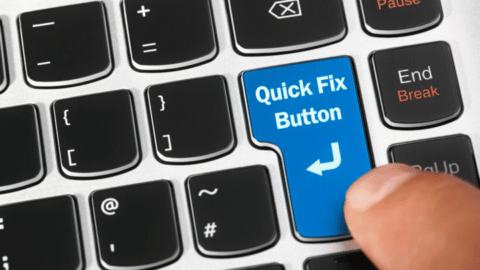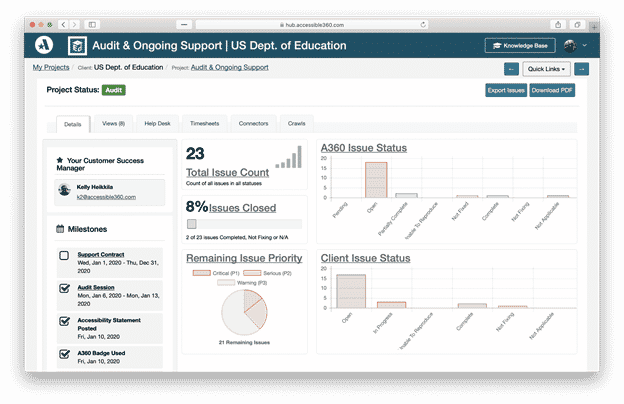
We would all like to find a quick fix for many things in life. Regarding digital accessibility for your website or mobile app, finding a “quick fix” may seem easy, but the correct fix is required to provide equitable access to all users. The National Federation of the Blind (NFB) recently provided much-needed insight on accessibility overlay tools.
Allyant agrees with the NFB’s overlay insights, which resulted from resounding pushback on sponsorship in this year’s conference. In this article, we will review:
- The NFB’s stance on overlay tools
- An absolute path to creating accessible technology
- How to get started on the path to WCAG Compliance for your website or mobile app
The NFB’s stance on overlay tools
Pointedly, the National Federation of the Blind took a stand against most overlays as a solution for digital access for the blind community (native screen reader users). This information came to light in their recently released resolutions, passed during the NFB’s National Convention on July 10, 2021.
NFB Resolution
Regarding overlay tools, the NFB has stated: “overlay providers attempt to convince website owners that overlays are the easiest and most affordable way to protect a website owner from lawsuits and make their websites accessible and compliant with the WCAG; and we demand that overlay providers stop making misleading, unproven, and unethical claims which falsely inflate the value and effectiveness of their technology.”
In addition, the NFB called out a few specific accessibility overlay tools and distinguished where they are failing the blind community of equitable access. The NFB board of directors went on to state that accessiBe in particular “overstates the effectiveness of automated testing by diminishing the importance of having actual humans participate in the user testing process and promotes the false claims of attaining Web Content Accessibility Guidelines compliance through the integration of one line of code.”

NFB Convention Statement Regarding Overlay Sponsorship
Furthermore, the NFB revoked accessiBe’s sponsorship of their 2021 National Convention. This resulted from the review of the overlay tool and urging from members and the blind community. In the NFB’s June 24th statement, they said, “This week, the Board of Directors reviewed accessiBe’s business practices at the urging of members who have researched and interacted with the company, and the Board believes that accessiBe currently engages in behavior that is harmful to the advancement of blind people in society.”

An actual path to creating accessible technology
The failure of quick fixes is well documented, such as in this Forbes article on accessibility overlays. With this in mind, let’s review the steps you or your company can take to create accessible technology.
Our approach to WCAG Compliance
Our approach to equitable digital access and WCAG Compliance is using humans, not a machine. This is the only effective way to look at and define the problems and solutions. Attempting to solve digital accessibility with a “tool” is a debunked method. In other words, it offers nothing more than a band-aid. Using a machine gives website operators a false sense of security that the site is accessible. Genuine usability, as defined by the WCAG success criteria, requires:
- Manual live-user testing that includes people with disabilities
- Design & development training by SMEs like our auditing staff
- Remediation of the issues includes making changes to the core code (HTML, CSS, JavaScript, etc.) of your website or application & conducting Quality Assurance Testing
- Ongoing Monitoring to ensure accessibility compliance is maintained
The only way to determine WCAG violations and begin working towards a solution is via testing with human technologists, like we do here at Allyant. For example, when reviewing websites or native applications, our auditors, many of whom are blind, utilize such tools as NVDA (NonVisual Desktop Access), an open-source screen reader software.

What to do for your websites & apps
So, if you have an overlay tool on your website because you didn’t know the truth, you are not alone.
Your Path to WCAG Compliance
As discussed, the mainstream media has exposed overlay tools’ inability to support WCAG Compliance. Now is the time to get on the right path to compliance with a live-user audit.
Start the process for your team in only four steps:
- Schedule an Intro Call – To better understand the scope of your project and the path to compliance.
- Schedule an audit – Start building out your remediation project plan heading into 2023.
- Post an Accessibility Statement – Show your commitment to working with a 3rd party auditor who tests with proven results.
- Gain access for your entire team (and 3rd party design/development agency) to our Accessibility Management Platform – Allowing you immediate access to our incredible Knowledge Base for designers & developers. Our Help Desk and our library of training videos and self-paced accessibility training modules allow your team to start building accessibility best practices into all of your digital communication.
Contact Allyant Today!
As the saying goes, “When you know better, you do better.” Something or someone tricked into believing an overlay tool would help provide equitable access to consumers with disabilities; you now know the truth. So contact us and mention you read this blog post, and we will give a discount for you to make the switch and correct your path to digital accessibility compliance.
Thank you, we’re looking forward to providing equitable access to all of your website visitors!

